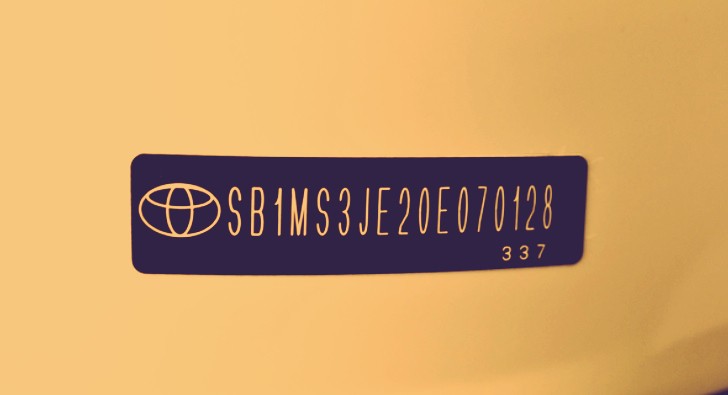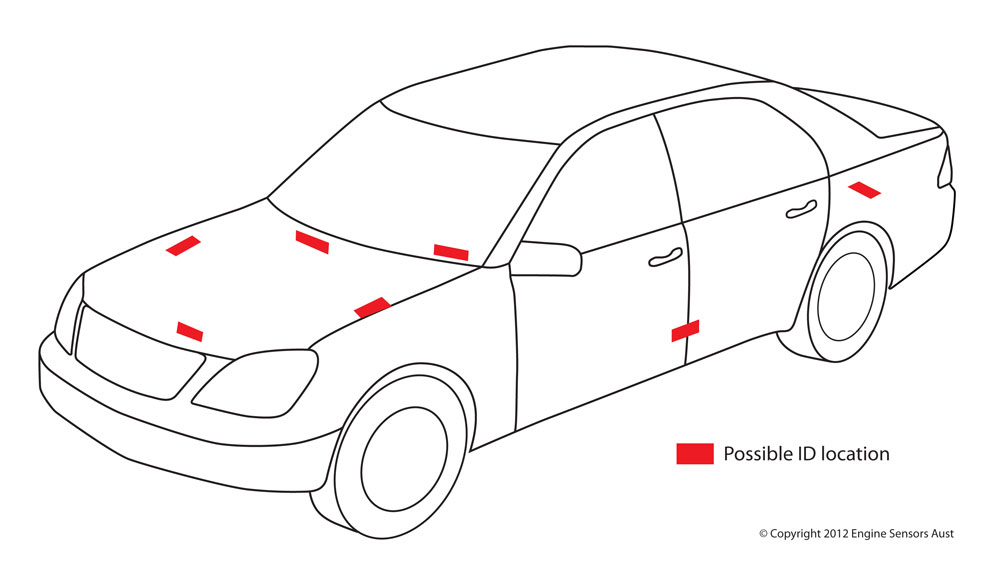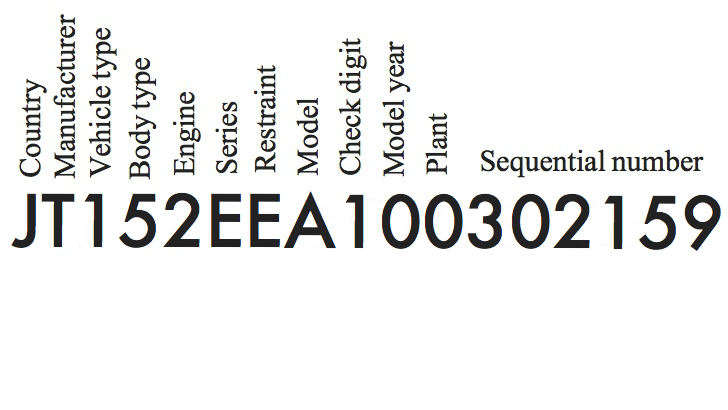Since vehicles started to be mass produced, every automaker out there started using VIN codes (Vehicle Identification Number) on each of their cars. Every car has its unique number which is used for different purposes but mostly for keeping track of each one of them on the road.
Usually, all VIN codes follow the same patter - a string of letters and numbers printed in some areas of the car, with each character meaning something if you know how to ‘read’ it. But each automaker has its own rules regarding what each letter and number mean, so here’s how Toyota VINs can be deciphered.
OK, now that you have a general idea of what they mean, lets see what other combinations can be found in the string.
Another important feature is that the VIN makes it harder for thieves to sell a stolen car. Of course, for this to happen, the buyer has to check the VIN before buying it. Simply meeting with a stranger, giving him the money and taking the car without having much of its history at hand will get you nowhere and if you manage to end up with a stolen car it will be a bit too late for the cops to catch the thief.
Last but not least, the VIN will help you order the right spare parts for your car. Most dealerships or online car parts shops will require you to enter the car's VIN in order to quickly provide you what's best for it.
How does the VIN code look?
The VIN is a string of 17 characters made out of both letters and numbers, all printed or stamped on a single line in some key locations on your car.Where can I find the VIN?
Usually, every manufacturer puts the VIN in very accessible locations so you can easily find it. So you should check on the lower part of the windshield on the driver’s side where there should be a small window showing the VIN printed on the dash. If your car is older, the VIN can be found either on the sticker or plate on the inside of the driver’s side door or the frame sill, or the glove compartment, under the spare tire, on the engine block or stamped somewhere in the engine bay. If everything else fails, check the vehicle insurance or vehicle registration documents.What those letters and numbers mean?
Here comes the tricky part as every letter and number in the VIN has a certain meaning depending on its position in the string. Here’s an overall meaning of them:OK, now that you have a general idea of what they mean, lets see what other combinations can be found in the string.
- Position 1 - this is the Country of Origin digit and here you can find both letters and numbers each with their own meaning: 1/USA, 2/Canada, 3/Mexico, 4/USA, 5/USA, 6/Australia, 8/Argentina, 9/Brazil, J/Japan, S/UK, M/Thailand, K/Korea and V/France.
- Position 2 - here is the manufacturer and it can be either N/NUMMI (New United Motor Manufacturing) or T/Toyota.
- Position 3 - shows the vehicle type: D,G,K,X,1,2,7,N/Passenger Car; A,B,F,M,4/Truck; E,L,3/Multipurpose Passenger Vehicle or SUV; 5/Incomplete Vehicle as in convertible.
- Position 4 - here you’ll find the body type of the of your vehicle: A/2DR sedan 2WD, B/4DR sedan 2WD or 4DR truck 4WD, C/2DR coupe 2WD, D/4DR truck 4WD, E/4DR truck 2WD, G/4DR wagon 2WD, H/4DR wagon 4WD, K/4DR wagon 2WD, L/4DR wagon 4WD or 4DR truck 4WD, M/5DR van 2WD, N/2DR regular cab truck 2WD, P/2DR regular cab truck 4WD, S/3DR liftback 4WD, T/2DR extended cab truck 2WD, X/5DR SUV, W/2DR extended cab 4WD, Y/sport van and Z/5DR wagon 2WD.
- Position 5 - shows what engine you got on your car: 4/7A-FE Lean Burn; A/3MZ-FE; B/1NZ-FXE or Toyota AZ engine#2AZ-FXE|2AZ-FXE; D/2ZZ-GE; E/2AZ-FE; F/1MZ-FE or 2AR-FE; G/5S-FE; H/1AZ-FE; J/1FZ-FE; K/2GR-FE; L/2RZ-FE; M/3RZ-FE; N/5VZ-FE or 2ZR-FXE; P/3S-FE; R/1ZZ-FE; S/1BM or Electric; T/3S-GTE; U/1GR-FE or 2ZR-FE; V/1NR-FE and Y/3UR-FE.
- Position 6 - the vehicle’s series, which is based on the chassis code given for your car
- Position 7 - safety features like seatbelts and airbags: 0/Manual Belts with 2 Airbags and Curtain Airbags; 1/Manual Belt; 2/Manual Belts with Driver Side Airbag; 3/Manual Belts with 2 Airbags; 6/Manual Belts with 2 Airbags, Side Airbags, Curtain Airbags and Knee Airbag for driver; 7/Manual Belts with 2 Airbags and Knee Airbag for driver; 8/Manual Belts with 2 Airbags and Side Airbags; D/Manual Belts with 2 Airbags, Side Airbags, Three-Row Curtain Airbags and Knee Airbag; F/Manual Belts with 2 Airbags, Side Airbags and Knee Airbag.
- Position 8 - which is the model or platform of the vehicle: 0/MR2 Spyder; 1/Tundra; 3/Echo and Yaris; 4/Scion xB and xD; 7/Scion tC; A/Highlander, Sequoia, Celica and Supra; B/Avalon; C/Sienna and Previa; D/T100; E/Corolla or Matrix; F/FJ Cruiser; G/Hilux; H/Highlander; J/Land Cruiser; K/Camry; L/Tercel and Paseo; M/Previa; N/Tacoma and older trucks; P/Camry Solara; R/4Runner and Corolla; T/Celica FWD; U/Prius; V/RAV4; W/MR2 non Spyder; X/Cressida.
- Position 9 - this is a check digit to verify the authenticity of the VIN. Usually it’s a number and it’s obtained using a mathematical formula.
- Position 10 - shows the car’s model year: V/1997; W/1998; X/1999; Y/2000; 1/2001; 2/2002; 3/2003; 4/2004; 5/2005; 6/2006; 7/2007; 8/2008; 9/2009; A/2010; B/2011; C/2012; D/2013; E/2014.
- Position 11 - indicates the factory where your car has been assembled: 0 to 9/Japan; A/Onnaing-Valenciennes, France; C/Cambridge, ON, CA; E/United Kingdom; K/Japan; M/Baja CA, Mexico; N/Kolín, Czech Republic; R/Lafayette, IN, US; S/Princeton, IN, US; U/Georgetown, KY, US; W/Woodstock, ON, CA; X/San Antonio, TX, US; Z/Fremont, CA, US.
- Position 12 to 17 - this shows the vehicle’s production number. They are usually used to show literally the unit’s number as it went out the assembly line. So this means 00004 is the fourth car of the respective year model produced. But sometimes this might not be the case.
Now, what can I do if I know what these numbers mean?
Well, first of all by reading the VIN and checking the rest of the components of a second hand car, you can tell if its the original build or it has been modified from the initial setup. Moreover, for a certain amount of cash, commercial services allow you to enter the VIN code and see the records on the respective car, which will show you how many owners it had as well as if it was stolen or crashed. If you are also a bit smarter and look at the whole picture the VIN provides, you can sometimes tell if the odometer has been rolled back or if it reached the maximum miles and started from zero again.Another important feature is that the VIN makes it harder for thieves to sell a stolen car. Of course, for this to happen, the buyer has to check the VIN before buying it. Simply meeting with a stranger, giving him the money and taking the car without having much of its history at hand will get you nowhere and if you manage to end up with a stolen car it will be a bit too late for the cops to catch the thief.
Last but not least, the VIN will help you order the right spare parts for your car. Most dealerships or online car parts shops will require you to enter the car's VIN in order to quickly provide you what's best for it.


